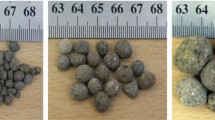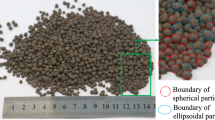Abstract
An integrated approach that combines a holistic numerical model and experiments is conducted to understand the compression behaviors of clay, which aims to link the microscopic particle interaction to its macroscopic compression behaviors. A novel Discrete Element Method (DEM) approach is implemented in this study that includes a customized interparticle force model considering the non-contact forces between particles (such as the long-range electrostatic repulsion and short-range van der Waals attraction) besides the direct contact force commonly adopted in the regular DEM model. The parameters for non-contact interparticle forces are obtained with the Atomic Force Microscope force measurement on kaolinite particles. The parameters for contact forces between particles, including the contact stiffness, are calibrated by the back analysis of experimentally measured compression curve of kaolinite clay. The unique DEM model is able to holistically predict the responses of kaolinite sample subjected to odometer test conditions under different loading and unloading paths, which allows to determine the compression index, the swell index and the preconsolidation pressure. The results show the compressibility of clay is linked to the changes in its microfabric subjected to increasing magnitudes of loads, which lead to increasing anisotropic fabric orientations, particularly for the load-carrying particles. The number of direct contacts per particle also increases. The particle platyness is found to contribute to the plasticity of soils when subjected to axial loads due to the irrecoverable change of particle fabric orientation, which is related to the swell index. The memorizing effect of clay on its preconsolidation pressure is found to be related to the particle-scale attraction, and an energy well exists between clay minerals due to the Coulomb repulsive force through the electrical double layer. Overall, this study demonstrates that the macroscopically observed engineering properties of clay, i.e., compression index Cc, swell index Cs and preconsolidation pressure Pp, bear rudimental causes from the fabric of particles and the fundamental interparticle forces. The memory of clay is attributed to the particle fabric and the energy well by non-contact interparticle forces.

















Similar content being viewed by others
Data availability
The datasets generated and/or analyzed during the current study are not publicly available but are available from the corresponding author on reasonable request.
References
Anandarajah A (2000) On influence of fabric anisotropy on the stress-strain behavior of clays. Comput Geotech 27:1–17
Anandarajah A (2003) Mechanism controlling permeability change in clays due to changes in pore fluid. J Geotech Geoenviron Eng 129(2):163–172
ASTM International (2011) Standard test methods for one-dimensional consolidation properties of soils using incremental loading. ASTM D2435/D2435M-11
Bandera S, O’Sullivan C, Angioletti-Uberti S, Tangney P (2019) An evaluation of contact models for particle-scale simulation of clay. E3S Web Conf 92:14001. https://doi.org/10.1051/e3sconf/20199214001
Bandera S, O’Sullivan C, Tangney P, Angioletti-Uberti S (2021) Coarse-grained molecular dynamics simulations of clay compression. Comput Geotech 138:104333
Bayesteh H, Mirghasemi AA (2013) Numerical simulation of pore fluid characteristic effect on the volume change behavior of montmorillonite clays. Comput Geotech 48:146–155
Bickmore BP, Hochella MF, Bosbach D, Charlet L (1999) Methods for performing atomic force microscopy imaging of clay minerals in aqueous solutions. Clays Clay Miner 47(5):573–581
Chang I, Kwon YM, Cho GC (2021) Effect of pore-fluid chemistry on the undrained shear strength of xanthan gum biopolymer-treated clays. J Geotech Geoenviron Eng 147(11):06021013
de Bono JP, McDowell GR (2022) Some important aspects of modelling clay platelet interactions using DEM. Powder Technol 398:117056
Dor M, Levi-Kalisman Y, Day-Stirrat RJ, Mishael Y, Emmanuel S (2020) Assembly of clay mineral platelets, tactoids, and aggregates: effect of mineral structure and solution salinity. J Colloid Interface Sci 566:163–170
Estabragh AR, Beytolahpour I, Moradi M, Javadi AA (2014) Consolidation behavior of two fine-grained soils contaminated by glycerol and ethanol. Eng Geol 178:102–108
Feng B, Liu H, Li Y, Liu X, Tian R, Li R, Li H (2020) AFM measurements of Hofmeister effects on clay mineral particle interaction forces. Appl Clay Sci 186:105443
Gelinas V, Vidal D (2010) Determination of particle shape distribution of clay using an automated AFM image analysis method. Powder Technol 203(2):254–264
Guo BL, Jiang JC, Serem W, Sharma VK, Ma XM (2019) Attachment of cerium oxide nanoparticles of different surface charges to kaolinite: molecular and atomic mechanisms. Environ Res 177:108645
Guo Y, Yu X (2017) Characterizing the surface charge of clay minerals with atomic force microscope (AFM). AIMS Mater Sci 4(3):582–593
Guo Y, Yu X (2018) A Holistic computational model for prediction of clay suspension structure. Int J Sedim Res 34:345–354
Guo Y, Yu X (2023) Insight on bulk shear strength parameters of clay using discrete element approach incorporating physics-based interparticle force model. Soils Found 63:101250
Gupta V, Miller JD (2010) Surface force measurements at the basal planes of ordered kaolinite particles. J Colloid Interface Sci 344(2):362–371
Hamaker HC (1937) The London-van der Waals attraction between spherical particles. Physica 4(10):1058–1072
Hicher PY, Wahyudi H, Tessier D (2000) Microstructural analysis of inherent and induced anisotropy in clay. Mech Cohes Friction Mater 5:341–371
Israelachvili JN (2011) Intermolecular and surface forces. Academic Press, Waltham
Itasca Consulting Group (2014) Particle flow code in 3 dimensions (PFC3D) manual
Jaradat K, Abdelaziz S (2019) On the use of discrete element method for multi-scale assessment of clay behavior. Comput Geotech 112:329–341
Jia R, Lei H, Li K (2020) Compressibility and microstructure evolution of different reconstituted clays during 1D compression. Int J Geomech 20(10):04020181
Kim YT, Do TH (2011) Experimental evaluation of leaching effects on the compressibility of marine clay and its strain rate dependency. Mar Georesour Geotechnol 29(1):16–29
Kumar N, Andersson MP, van den Ende D, Mugele F, Siretanu I (2017) Probing the surface charge on the basal planes of kaolinite particles with high-resolution atomic force microscopy. Langmuir 33(50):14226–14237
Lide DR (2004) CRC handbook of chemistry and physics, 85th edn
Lifshitz EM (1956) The theory of molecular attractive forces between solids. Soviet Phys 2(1):73–83
Liu J, Miller JD, Yin XH, Gupta V, Wang XM (2014) Influence of ionic strength on the surface charge and interaction of layered silicate particles. J Colloid Interface Sci 432:270–277
Liu J, Lin CL, Miller JD (2015) Simulation of cluster formation from kaolinite suspensions. Int J Miner Process 145:38–47
Lu N, Anderson MT, Likos WJ, Mustoe GW (2008) A discrete element model for kaolinite aggregate formation during sedimentation. Int J Numer Anal Meth Geomech 32(8):965–980
Luo LS, Shen ZF, Gao HM, Wang ZH, Zhou X (2021) Macroscopic behavior and microscopic structure evolution of marine clay in one-dimensional compression revealed by discrete element simulation. Process 9(12):2259
Mitchell JK, Soga K (2005) Fundamentals of soil behavior, 3rd edn. Wiley, Hoboken
Moein K, Mirghasemi AA, Bayesteh H (2018) Compressibility of montmorillonite/kaolinite mixtures in consolidation testing using discrete element method. Comput Geotech 104:271–280
Ng CW, Akinniyi DB, Zhou C (2020) Influence of structure on the compression and shear behaviour of a saturated lateritic clay. Acta Geotech 15:3433–3441
Nortemann K, Hilland J, Kaatze U (1997) Dielectric properties of aqueous NaCl solutions at microwave frequencies. J Phys Chem A 101(37):6864–6869
Pagano AG, Magnanimo V, Weinhart T, Tarantino A (2020) Exploring the micromechanics of non-active clays by way of virtual DEM experiments. Geotechnique 70(4):303–316
Pedrotti M, Tarantino AA (2018) An experimental investigation into the micromechanics of non-active clays. Geotechnique 68(8):666–683
Penumadu D, Dean J (2000) Compressibility effect in evaluating the pore-size distribution of kaolin clay using mercury intrusion porosimetry. Can Geotech J 37(2):393–405
Piner R, Xu T, Fisher F, Qiao Y, Ruoff R (2003) Atomic force microscopy study of clay nanoplatelets and their impurities. Langmuir 19(19):7995–8001
Rajasekaran G, Rao S (2002) Compressibility behaviour of lime-treated marine clay. Ocean Eng 29:545–559
Russel WB, Saville DA, Schowalter WR (1989) Colloidal dispersions. Cambridge University Press, Cambridge
Sachan A, Penumadu D (2007) Identification of microfabric of kaolinite clay mineral using X-ray diffraction technique. Geotech Geol Eng 25:603–616
Sachan A, Vikash G, Prashant A (2013) Development of intermediate microfabric in kaolin clay and its consolidation behaviour. Geotech Geol Eng 31:23–34
Schanz T, Tripathy S, Sridharan A (2018) Volume change behaviour of swelling and non-swelling clays upon inundation with water and a low dielectric constant fluid. Appl Clay Sci 158:219–225
Shoaib M, Bobicki ER (2021) Rheological implications of pH induced particle-particle association in aqueous suspension of an anisotropic charged clay. Soft Matter 17(34):7822–7834
Song M, Zeng L, Hong Z (2017) Pore fluid salinity effects on physicochemical-compressive behaviour of reconstituted marine clays. Appl Clay Sci 146:270–277
Tripathy S, Schanz T (2007) Compressibility behaviour of clays at large pressures. Can Geotech J 44:355–362
Wang S, Miao Y, Wang L (2020) Investigation of the force evolution in aggregate blend compaction process and the effect of elongated and flat particles using DEM. Constr Build Mater 258:119674
Wei YZ, Chiang P, Sridhar S (1992) Ion size effects on the dynamic and static dielectric properties of aqueous alkali solutions. J Chem Phys 96(6):4569–4573
Xie Y, Yang J, Zhang C, Qu T, Wang S, Fu J (2023) A quantitative evaluation method for granular skeleton state of binary soils at arbitrary relative density. Comput Geotech 153:105083
Yao M, Anandarajah A (2003) Three-dimensional discrete element method of analysis of clays. J Eng Mech 129(6):285–296
Yin XH, Yan LJ, Liu J, Xu ZH, Miller JD (2013) Anisotropic surface charging of chlorite surfaces. Clays Clay Miner 61(1–2):152–164
Yuan SY, Liu XF, Sloan SW, Buzzi OP (2016) Multi-scale characterization of swelling behaviour of compacted Maryland clay. Acta Geotech 11(4):789–804
Zbik MS, Raftery NA, Smart RS, Frost RL (2010) Kaolinite platelet orientation for XRD and AFM applications. Appl Clay Sci 50(3):299–304
Acknowledgements
This research is partially supported by the US National Science Foundation via Grant No. 0900401. The lead author, Dr. Guo, a former graduate research assistant at Case Western Reserve University, is also funded by National Nature Science Foundation of China (Grant No. 42107167) and Department of Science and Technology of Guandong Province (2021ZT09G087).
Author information
Authors and Affiliations
Corresponding author
Additional information
Publisher's Note
Springer Nature remains neutral with regard to jurisdictional claims in published maps and institutional affiliations.
Rights and permissions
Springer Nature or its licensor (e.g. a society or other partner) holds exclusive rights to this article under a publishing agreement with the author(s) or other rightsholder(s); author self-archiving of the accepted manuscript version of this article is solely governed by the terms of such publishing agreement and applicable law.
About this article
Cite this article
Guo, Y., Yu, X. Insight into on compression behaviors of clay from a novel discrete element model considering non-contact interparticle forces. Acta Geotech. 18, 4583–4597 (2023). https://doi.org/10.1007/s11440-023-01867-8
Received:
Accepted:
Published:
Issue Date:
DOI: https://doi.org/10.1007/s11440-023-01867-8




